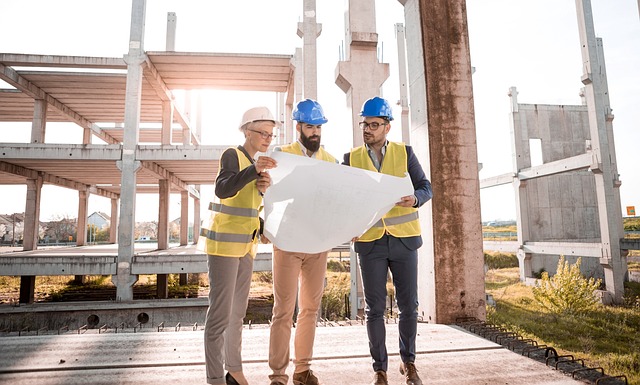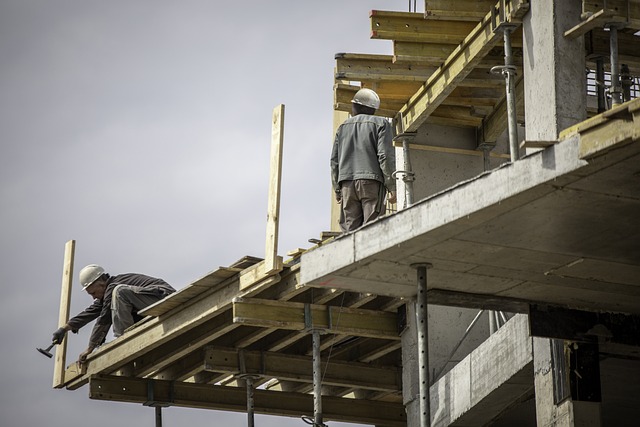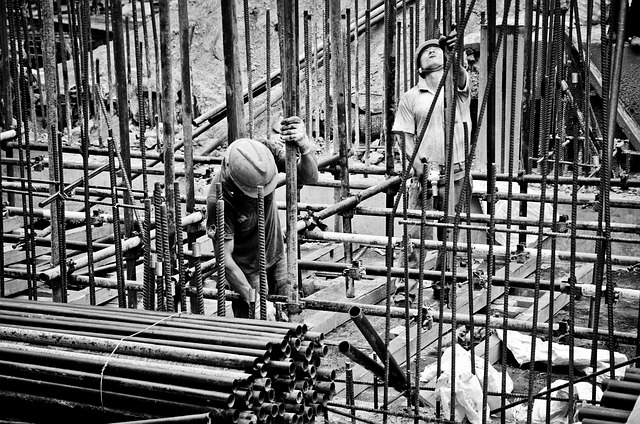Hands-free headlamps for construction workers have revolutionized job site lighting, offering both hands-free operation and superior illumination that traditional flashlights cannot match. These advanced devices are designed to be durable, comfortable, and resilient against the elements, with adjustable brightness settings to meet various tasks' needs without draining batteries quickly. The best models like the Streamlight 61750 and Klein Tools 2038P LED Hat Light provide high lumen output and are engineered to last throughout the toughest construction projects. As technology advances, we can expect further innovations such as AR capabilities in headlamps, which will offer workers real-time data and enhance safety and precision on the job. The ongoing evolution of flashlights for construction workers is focused on improving efficiency, safety, and task performance, making them indispensable tools on modern construction sites.
Construction sites are dynamic environments where visibility and precision are paramount. The integration of hands-free headlamps has revolutionized the way construction workers illuminate their work areas, enhancing both efficiency and safety. This article explores the transformative impact of these devices on construction tasks, tracing their evolution from manual flashlights to advanced hands-free solutions. We will delve into the pivotal features that define a top-tier headlamp for construction sites, address critical safety considerations, and offer best practices for deploying these tools in various settings. Additionally, we’ll examine the latest innovations in hands-free lighting technology, ensuring construction workers have access to the most effective flashlights for their demanding operations. Join us as we shed light on the bright future of hands-free headlamps in the construction industry.
- Maximizing Efficiency and Safety with Hands-Free Headlamps for Construction Workers
- The Evolution of Flashlights in Construction: From Manual to Hands-Free Technology
- Key Features to Look for in a High-Quality Hands-Free Headlamp for Construction Sites
- Safety Considerations: How Hands-Free Headlamps Reduce Risks on Construction Sites
- Best Practices for Using Hands-Free Headlamps in Different Construction Environments
- Comparing Top Hands-Free Headlamp Models for Construction Applications
- Innovations in Hands-Free Lighting: What's Next for Flashlights in Construction Worker Operations?
Maximizing Efficiency and Safety with Hands-Free Headlamps for Construction Workers

Construction sites are dynamic environments where efficiency and safety are paramount. Flashlights for construction workers have evolved to meet these demands, with hands-free headlamps emerging as a game-changer in optimizing both productivity and personal well-being on the job. These innovative lighting solutions free up a worker’s hands, allowing for unobstructed work in tight spaces or while manipulating tools and materials. The adaptability of headlamps means that construction workers can maintain optimal visibility without the need to hold a flashlight, which can be cumbersome and restrictive.
The ergonomic design of modern hands-free headlamps ensures that construction workers’ hands are available for the task at hand, whether it’s laying bricks, installing electrical wiring, or any other intricate work that requires both skill and precision. The adjustable brightness settings on these headlamps cater to varying light conditions, from the dimly lit corners of a building under construction to outdoor sites exposed to natural daylight. With long battery lives and durable, weather-resistant construction, hands-free headlamps provide reliable illumination throughout a worker’s shift, reducing the risk of injury or accidents caused by temporary hands occupancy with a flashlight. This not only enhances efficiency but also contributes significantly to the overall safety of construction sites.
The Evolution of Flashlights in Construction: From Manual to Hands-Free Technology

Flashlights have undergone a significant transformation over the years, evolving from their manual origins to become indispensable hands-free technology in construction environments. Traditionally, construction workers relied on manual flashlights, which required constant holding and adjustment, often leading to fatigue and reduced productivity. As the industry progressed, the design of flashlights began to adapt to the needs of workers, with the introduction of hands-free headlamps marking a pivotal shift in how light is utilized on construction sites. These advancements have not only enhanced worker safety by freeing up their hands for tasks at hand but also increased efficiency and output by allowing for continuous illumination of work areas. The evolution of flashlights for construction workers is a testament to human ingenuity, as each iteration has addressed specific challenges faced in the field. Today, the latest models of hands-free headlamps boast high-intensity lighting, long battery life, and durable designs, making them an essential tool for any construction professional. The integration of LED technology has further improved the quality of light, offering a brighter and more focused beam that closely mimics natural daylight. This has significantly improved visibility in dark or poorly lit areas, which is crucial for precision and safety during late-night shifts or work in enclosed spaces. The transition from manual to hands-free lighting solutions reflects the broader trend of technological advancement aimed at optimizing performance and enhancing worker safety across construction sites.
Key Features to Look for in a High-Quality Hands-Free Headlamp for Construction Sites

When selecting a high-quality hands-free headlamp for construction workers, several key features stand out as essential for optimal performance and safety on the job. Firstly, durability is paramount; the headlamp should be built to withstand the rigorous conditions of a construction site, including exposure to dust, water, and drops from heights. A robust design ensures that the headlamp can endure the demands of daily use without failure.
Secondly, brightness and beam focus are critical components. Construction workers often operate in environments ranging from dim interiors to well-lit spaces, necessitating a versatile light output. High lumens output allows for clear visibility in dark areas, while an adjustable focus enables users to narrow or widen the light beam as needed. Additionally, LED technology is preferred due to its longevity and energy efficiency compared to traditional bulbs. Features such as multiple lighting modes—high, low, and strobe—provide flexibility for various tasks, enhancing safety and productivity throughout the workday. The inclusion of red or green night vision modes can also preserve workers’ night adaptation, reducing eye strain when moving between well-lit and dark areas. For construction workers who often work with their hands, a comfortable, adjustable headband ensures the headlamp stays securely in place without causing discomfort or impeding manual tasks. Considering these features, a high-quality hands-free headlamp can significantly improve the working conditions for construction workers, leading to better precision and safety on the job site.
Safety Considerations: How Hands-Free Headlamps Reduce Risks on Construction Sites

Hands-free headlamps represent a significant advancement in illumination technology for construction workers, particularly when it comes to safety and efficiency on job sites. Unlike traditional flashlights that require manual handling, headlamps free up both hands, allowing workers to manage tools and materials with greater dexterity and safety. This ergonomic advantage is crucial in preventing accidents caused by momentary lapses in holding a flashlight, thus reducing the risk of injuries from drops or fumbles. The adjustable light direction of hands-free headlamps also enables workers to direct illumination precisely where it’s needed, whether it’s for inspecting fine details or navigating complex layouts. Moreover, the durability and robust construction of these headlamps ensure that they can withstand the rigorous conditions often encountered in a construction environment, making them a reliable source of light even in harsh weather or challenging positions. Flashlights for construction workers, when designed with hands-free functionality, significantly contribute to a safer and more productive worksite by minimizing the potential for accidents and optimizing the use of both hands for task execution. The integration of long-lasting LED technology further enhances their utility, providing consistent brightness over extended hours, which is essential for extended shifts or overnight tasks.
Best Practices for Using Hands-Free Headlamps in Different Construction Environments

When integrating hands-free headlamps into construction tasks, it’s crucial to select a model that offers durability and reliability, such as those designed specifically for flashlights for construction workers. These robust headlamps are engineered to withstand the rigors of a construction site while providing consistent illumination, which is essential for maintaining safety and efficiency in low-light conditions. To maximize the effectiveness of hands-free headlamps, construction workers should position the lamp so that the light beam falls directly where it’s needed, minimizing glare and ensuring optimal visibility.
The selection of the correct lighting mode on the headlamp is also a best practice. Many modern headlamps offer various modes, including high, medium, low, and even red or strobe settings. The choice of mode can be dependent on the task at hand—high intensity for detailed work in darker areas, lower settings for less critical tasks to conserve battery life, and specialized modes for increased safety during nighttime roadwork or in environments where visual signals are important. Additionally, workers should regularly check the headlamp’s battery status, as unexpected power loss can halt operations and pose safety risks. By following these best practices and utilizing flashlights for construction workers designed with the needs of the job in mind, construction teams can enhance their performance and ensure a safer worksite.
Comparing Top Hands-Free Headlamp Models for Construction Applications

When it comes to construction sites, hands-free headlamps have become indispensable tools for workers who need both their hands and excellent illumination in low-light conditions. Flashlights for construction workers have evolved significantly, with hands-free headlamp models leading the charge in innovation and functionality. These advanced headlamps offer a superior alternative to traditional flashlights, ensuring that construction personnel can navigate complex tasks without the encumbrance of holding a light source.
Comparing the top hands-free headlamp models reveals a range of features tailored specifically for construction applications. Models like the Streamlight 61750 and the Klein Tools 2038P LED Hat Light are frequently cited for their robust build quality and high lumen output, which is crucial for illuminating work areas in complete darkness. Both models boast long battery lives, adjustable beams, and sturdy construction, making them ideal for the demanding conditions of a construction site. The choice between a headband or a hat-mounted light depends on personal preference and the specific requirements of the job. Each model offers a comfortable fit and ergonomic design to minimize fatigue during prolonged use. Additionally, the latest hands-free headlamps come with impact-resistant housings, waterproofing, and high-quality LEDs that can last for thousands of hours. These features make them not only reliable but also cost-effective over time, as they require less frequent replacement and maintenance compared to conventional flashlights.
Innovations in Hands-Free Lighting: What's Next for Flashlights in Construction Worker Operations?

The integration of hands-free headlamps in construction work environments has revolutionized the way tasks are performed, particularly during early morning setups or late evening wrap-ups. Traditional flashlights for construction workers have made way for advanced lighting solutions that offer both hands-free operation and superior illumination. These innovative headlamps are equipped with high-intensity LEDs, capable of delivering a bright, focused beam where it’s needed most. The latest models feature adjustable brightness settings, allowing workers to conserve battery life during less demanding tasks while having the option to maximize lumens for more critical operations. Additionally, the incorporation of durable, lightweight materials ensures that these headlamps are comfortable over extended periods and can withstand the rigorous conditions found on construction sites.
Looking ahead, the next frontier in hands-free lighting for construction workers promises even greater advancements. Manufacturers are focusing on developing headlamps with augmented reality (AR) capabilities, which could overlay digital information onto the real-world view of the worker. This technology would enable construction professionals to not only see their work area clearly but also to access blueprints, safety warnings, or even real-time data overlays through their eyewear. Moreover, advancements in battery technology and energy efficiency are set to extend runtime and reduce the need for frequent power sourcing. These upcoming innovations are poised to further enhance the efficiency, accuracy, and safety of flashlights for construction workers, transforming the way they navigate and complete tasks in dynamic and demanding environments.
In conclusion, the adoption of hands-free headlamps represents a significant leap forward for construction workers, enhancing both efficiency and safety on job sites. The evolution from manual flashlights to advanced hands-free headlamp technology has been transformative, offering a brighter and more secure work environment. When selecting a headlamp, key features such as durability, brightness, battery life, and comfort should be prioritized to ensure optimal performance in various construction settings. By adhering to best practices for their use, workers can leverage these tools to improve task visibility without compromising on manual dexterity or mobility. As we look ahead, ongoing innovations in hands-free lighting promise even greater advancements for flashlights used by construction workers, signaling a future where lighting solutions become increasingly integrated and essential to the trade. It’s clear that this technology is not just a novelty but a pivotal tool for enhancing productivity and minimizing risks on construction sites.
